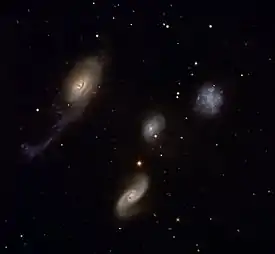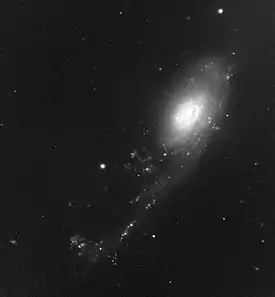| Robert's Quartet | |
|---|---|
 | |
| Observation data (Epoch J2000) | |
| Constellation(s) | Phoenix |
| Right ascension | 0h 21m 23.075s |
| Declination | −48° 37.75′ 39.5″ |
| Brightest member | NGC 92 |
| Number of galaxies | 4 |
| Other designations | |
| AM 0018-485 | |
Robert's Quartet is a compact galaxy group approximately 160 million light-years away in the constellation Phoenix. It is a family of four very different galaxies whose proximity to each other has caused the creation of about 200 star-forming regions and pulled out a stream of gas and dust 100,000 light years long.[1] Its members are NGC 87, NGC 88, NGC 89 and NGC 92, discovered by John Herschel on the 30 September 1834.[2]
The quartet is one of the best examples of compact galaxy groups.[1] Because such groups contain four to eight galaxies in a very small region they are excellent laboratories for the study of galactic interactions and their effects, in particular on the formation of stars.[3] The quartet has a total visual magnitude of almost 13.[3] The brightest member of the group is NGC 92, having the blue magnitude of 13.8.[4] On the sky, the four galaxies are all within a circle of radius of 1.6 arcmin, corresponding to about 75,000 light-years.[3] It was named by Halton Arp and Barry F. Madore, who compiled A Catalogue of Southern Peculiar Galaxies and Associations in 1987.[3] Arp and Madore named Robert's Quartet after Robert Freedman who generated many of the updated positions of galaxies in the catalogue.[3]
Members
| Name | Type | Distance from Sun (million ly) |
Magnitude |
|---|---|---|---|
| NGC 87 | IBm pec. | ~160 | +14.50 |
| NGC 88 | SB(rs)a pec. | ~160 | +15.21 |
| NGC 89 | SB0(s)a pec. | ~160 | +14.57 |
| NGC 92 | SAa pec. | ~160 | +14.29 |

See also
- Wild's Triplet
- Zwicky's Triplet
- Stephan's Quintet and NGC 7331 Group (Also known as the Deer Lick Group about half a degree northeast of Stephan's Quintet)
- Seyfert's Sextet
- Copeland Septet
References
- 1 2 Darling, David. "Robert's Quartet". David Darling. Retrieved 21 January 2019.
- ↑ Herschel, John Frederick William (1847). Results of astronomical observations made during the years 1834, 5, 6, 7, 8, at the Cape of Good Hope: being the completion of a telescopic survey of the whole surface of the visible heavens, commenced in 1825. Vol. 1. London, United Kingdom: Smith, Elder and Co. p. 51. Bibcode:1847raom.book.....H.
- 1 2 3 4 5 "Cosmic Portrait of a Perturbed Family". European Southern Observatory. Retrieved 21 January 2019.
- ↑ "NGC 92". SIMBAD. Centre de données astronomiques de Strasbourg. Retrieved 2017-09-24.
External links
- ESo: Cosmic Portrait of a Perturbed Family
- "What's In A Name?"
- Robert's Quartet on WikiSky: DSS2, SDSS, GALEX, IRAS, Hydrogen α, X-Ray, Astrophoto, Sky Map, Articles and images